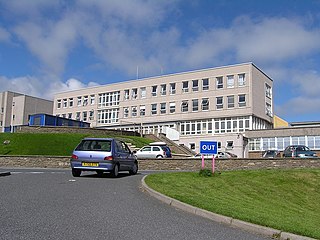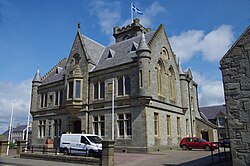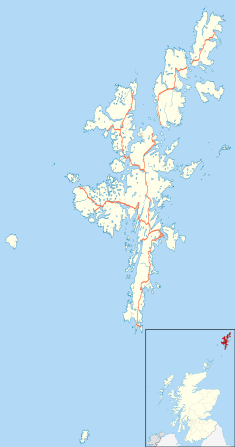
Shetland, also called the Shetland Islands, is an archipelago in Scotland lying between Orkney, the Faroe Islands, and Norway. It is the northernmost region of the United Kingdom.

Kirkwall is the largest town in Orkney, an archipelago to the north of mainland Scotland. First mentioned in the Orkneyinga saga, it is today the location of the headquarters of the Orkney Islands Council and a transport hub with ferries to many locations. It is the centre of the St Magnus International Festival and is also a popular stopping off point for cruise ships. St Magnus Cathedral stands at the heart of the town.

Lerwick is the main town and port of the Shetland archipelago, Scotland. Shetland's only burgh, Lerwick had a population of about 7,000 residents in 2010. It is the northernmost major settlement within the United Kingdom.

The Anderson High School (AHS) is a comprehensive secondary school in Lerwick, Shetland, Scotland. The AHS is the largest school in Shetland with around 67 staff and about 800-900 pupils from age 12 to 18.

The New Club is a private social club in the New Town area of Edinburgh, Scotland. Founded in 1787, it is Scotland's oldest club. The club occupied premises on St Andrew Square from 1809 until 1837, when it moved to purpose-built rooms on Princes Street. The 1837 building was replaced with a modern building to a design by Reiach and Hall, which is protected as a category A listed building. Women were admitted in 1970, and offered full membership from 2010.

The Shetland Islands Council is the local authority for the Shetland Islands, one of the 32 council areas of Scotland. It was established in 1975 by the Local Government (Scotland) Act 1973 and was largely unaffected by the Scottish local government changes of 1996.

The Shetland Museum and Archives is a museum in Lerwick, Shetland, Scotland. The new Shetland Museum at Hay's Dock was officially opened on 31 May 2007 by Queen Sonja of Norway and the Duke & Duchess of Rothesay.

The Böd of Gremista, situated at the north end of Lerwick, Shetland, Scotland, is a typical 18th-century Shetland fishing booth. It is protected as a category B listed building.

The Gilbert Bain Hospital is a rural general hospital in the burgh of Lerwick, Shetland, Scotland. It is managed by NHS Shetland.

Quarff is a small village on Mainland in the Shetland Islands in Scotland. It is located on the main A970 road, 5 miles (8.0 km) south of Shetland's only town, Lerwick. The village is spread along a classic glacial valley that runs east–west across the island between high hills to north and south, with centres of population at Easter Quarff which is near the main road and the east coast, and Wester Quarff which is 11⁄2 miles (2.4 km) west and faces the Atlantic Ocean. A narrow road runs along the valley between the two.

Fulham Town Hall is a municipal building on Fulham Road, Fulham, London. It is a Grade II* listed building.

The main power supply for Shetland is provided by Lerwick Power Station, located in Gremista, 2 kilometres (1.2 mi) northwest of Lerwick town centre. This is the principal source of electrical energy for Shetland, however currently about 20 MWe is provided by the Sullom Voe Terminal power station which comprises 4 x 23 MWe Gas Turbines, the future of which is uncertain. Opened on 27 May 1953 the station is diesel-fuelled and generates a total of 66 MW of power.

Shetland Library is the public library service of Shetland, with its main branch based in Lerwick. Membership is open to both residents of and visitors to the islands. The library has a range of digital, online and physical material and collections that support the literary traditions of the Northern Isles.

The Old Town Hall, Richmond, on Whittaker Avenue in Richmond, London, is a former municipal building which from 1893 to 1965 served as the town hall for the Municipal Borough of Richmond.

Dundee City Chambers is a municipal facility in City Square, Dundee, Scotland. The city chambers, which is headquarters of Dundee City Council, is a Category B listed building.

Berwick Town Hall is a municipal facility in Marygate, Berwick-upon-Tweed, England. The town hall, which was the headquarters of Berwick-upon-Tweed Borough Council, is a Grade I listed building.

Wakefield Town Hall is a municipal building in Wood Street in Wakefield, West Yorkshire, England. It remains a venue for weddings and civil partnerships but is no longer the headquarters of Wakefield Council which is now based at County Hall. The town hall is a Grade I listed building.

Galashiels Burgh Chambers is a municipal building in Albert Place, Galashiels, Scotland. The building, which was the headquarters of Galashiels Burgh Council, is a Category B listed building.

County Buildings is a municipal structure in King Erik Street, Lerwick, Shetland, Scotland. The structure, which is used as a judicial complex, is a Category B listed building.

Lerwick Tolbooth is a former judicial building on Commercial Street in Lerwick in Shetland in Scotland. The building, which is used as a lifeboat station, is a Category B listed building.






















